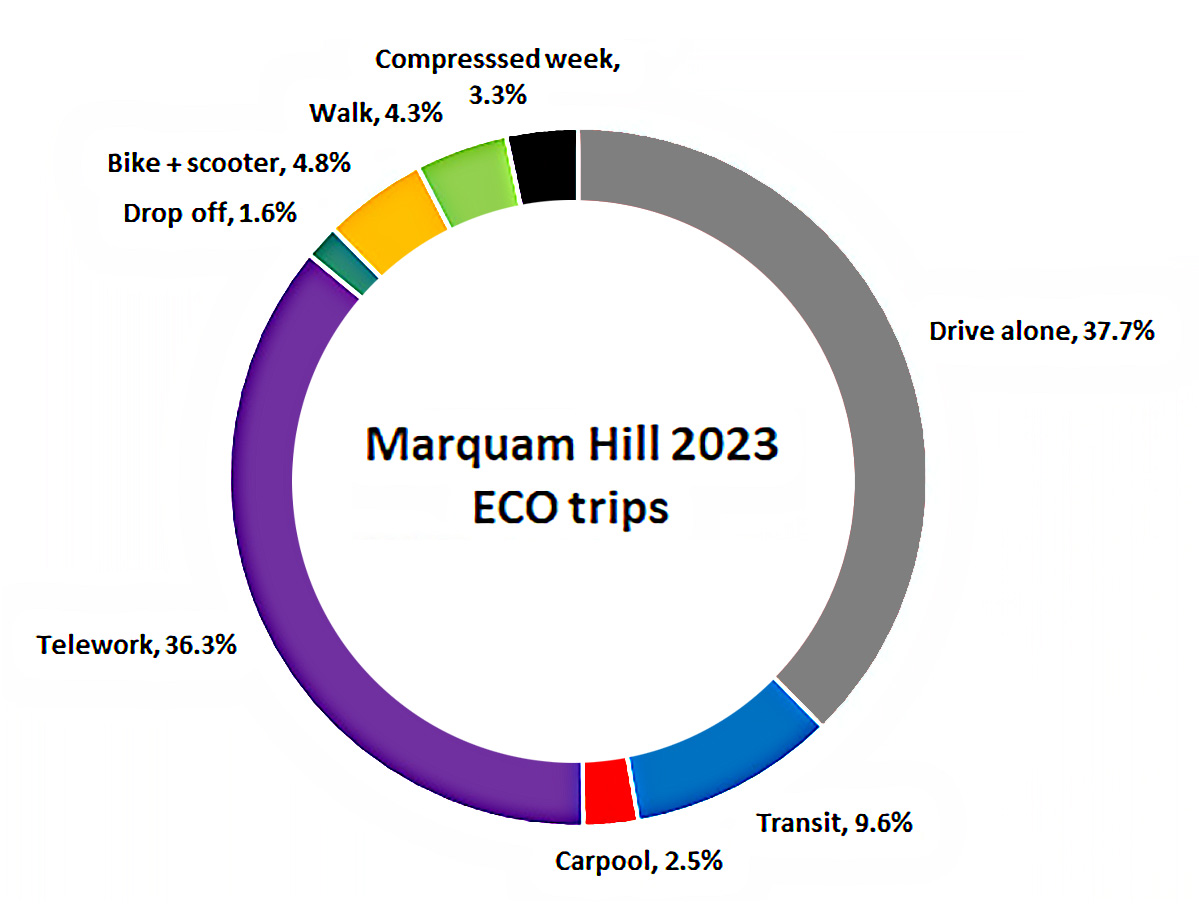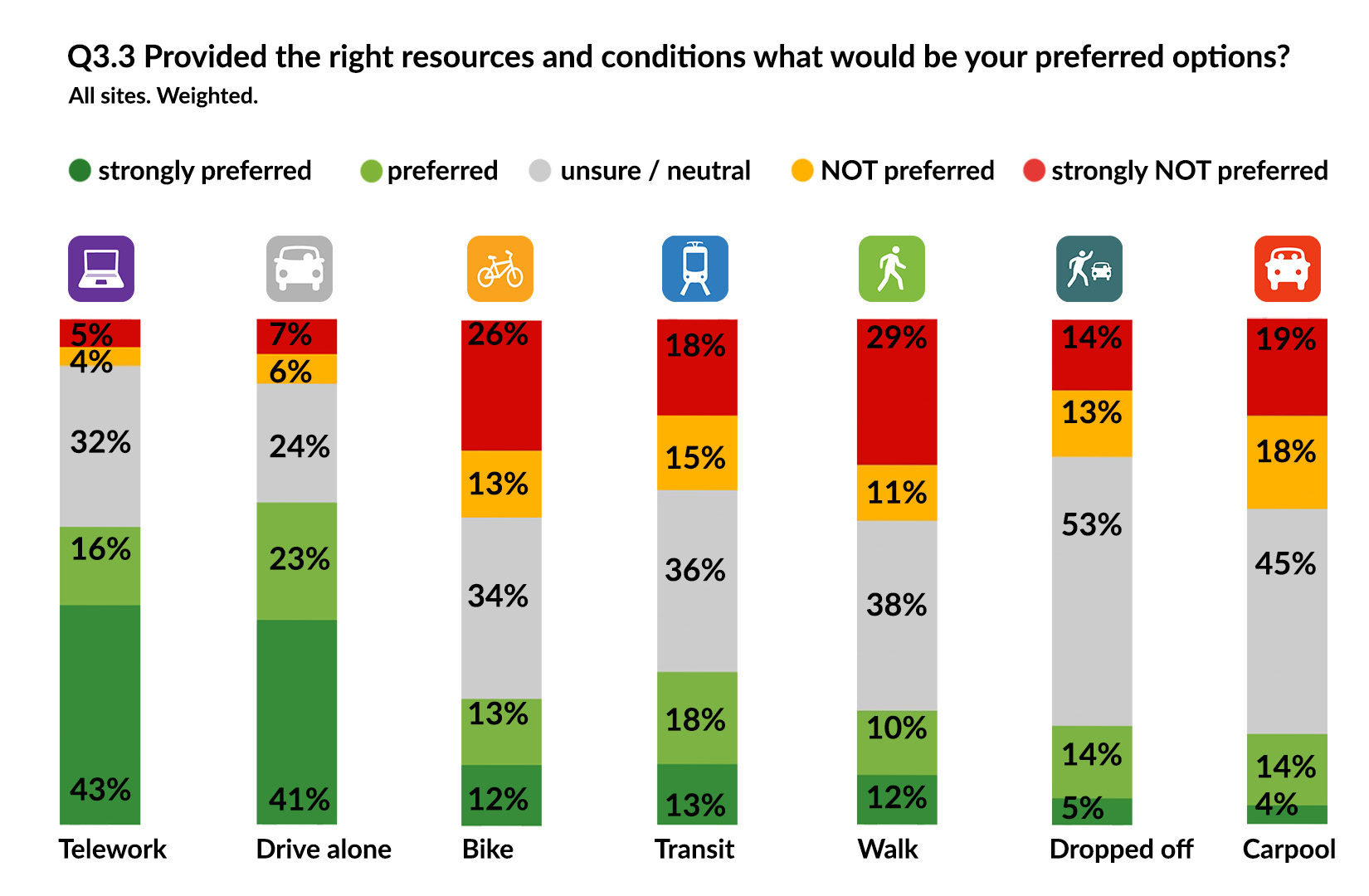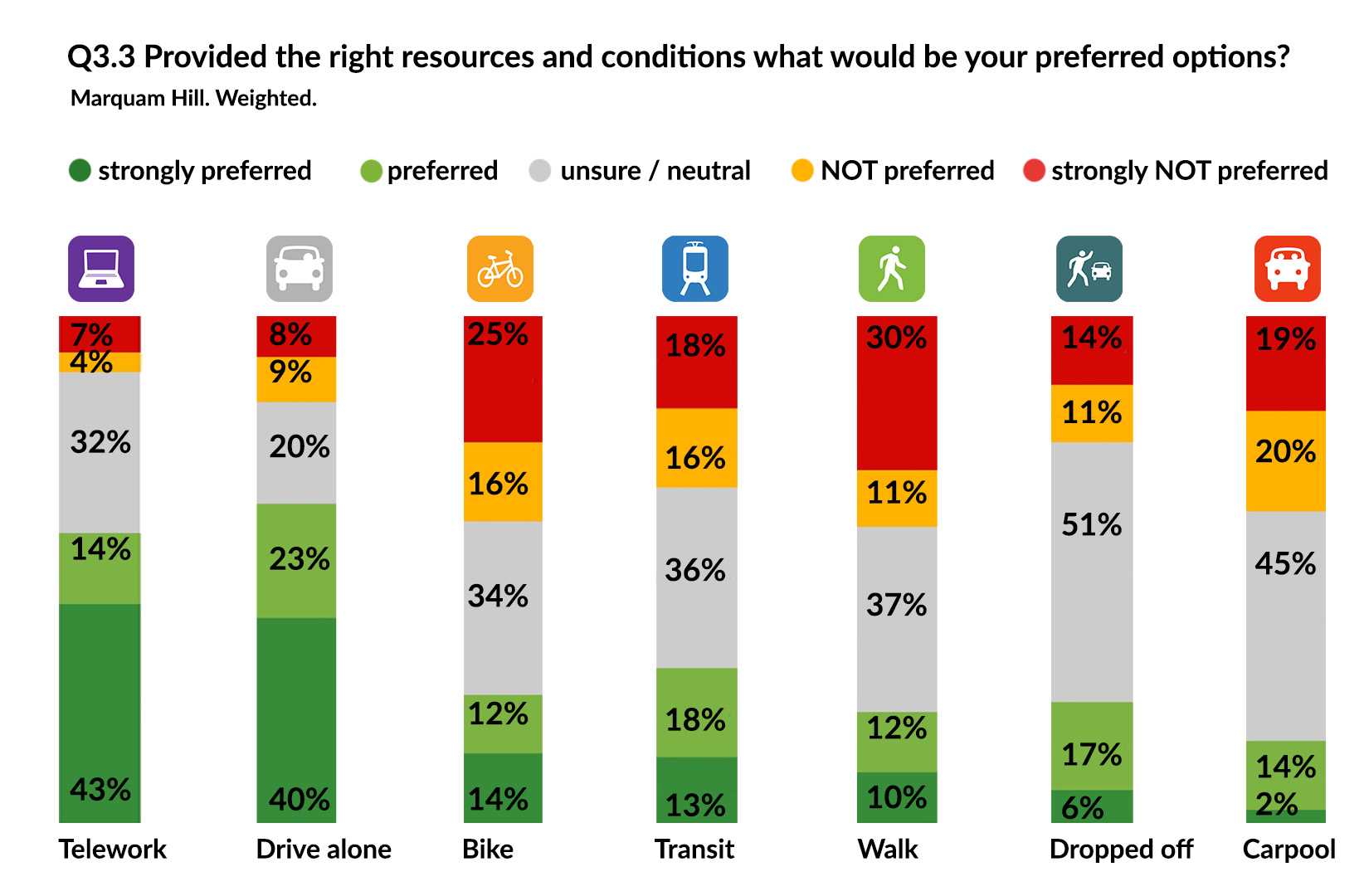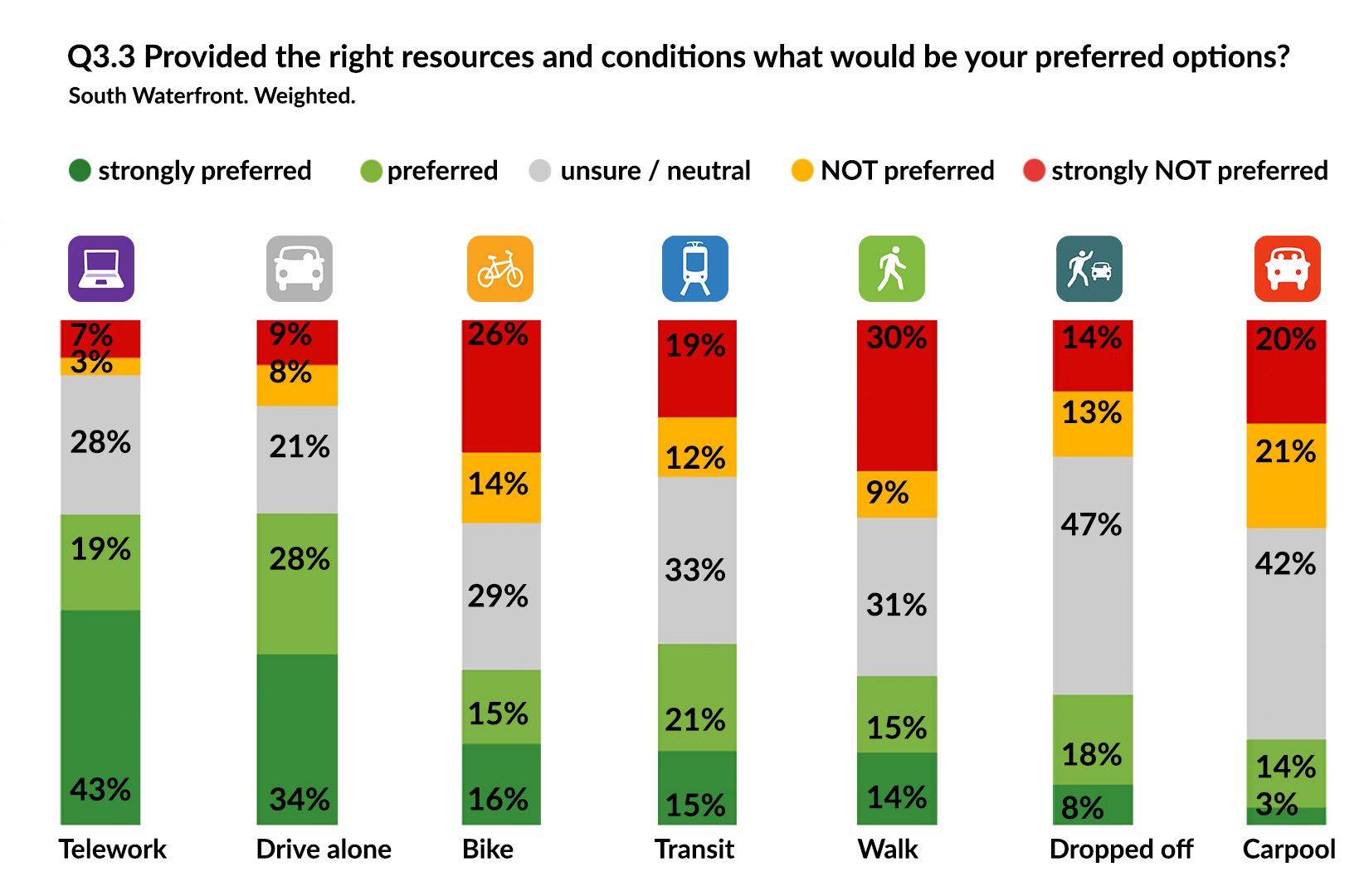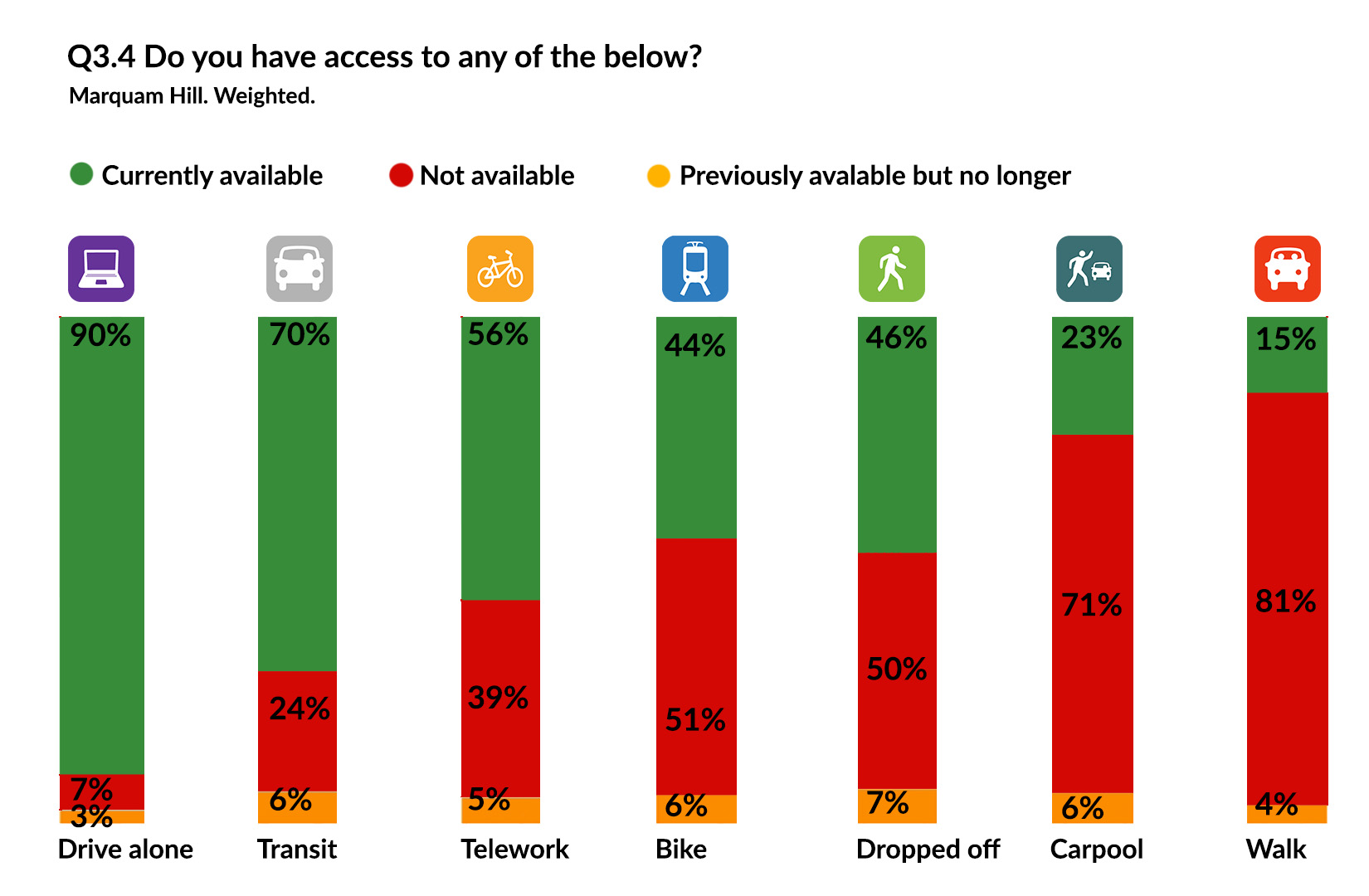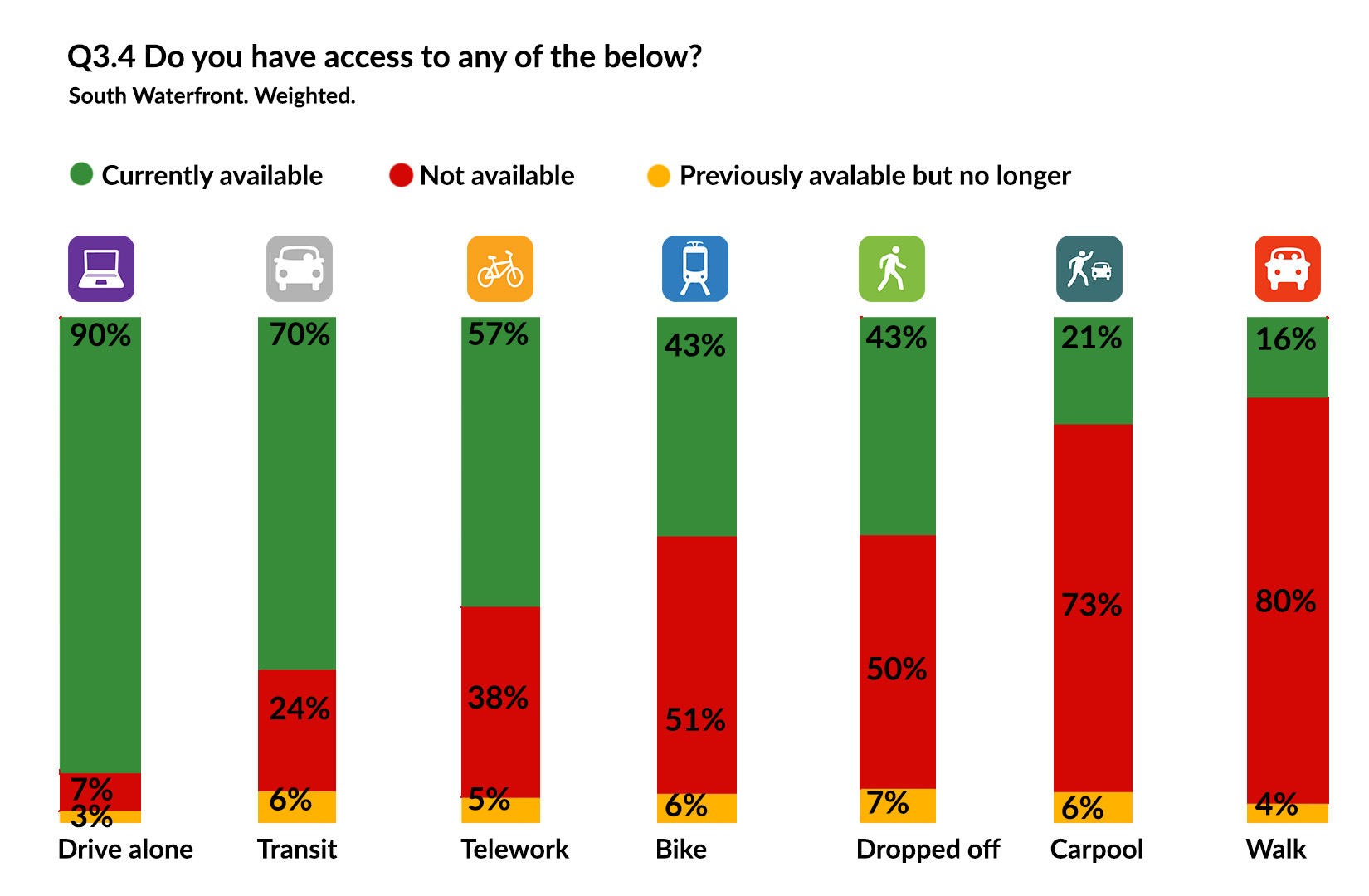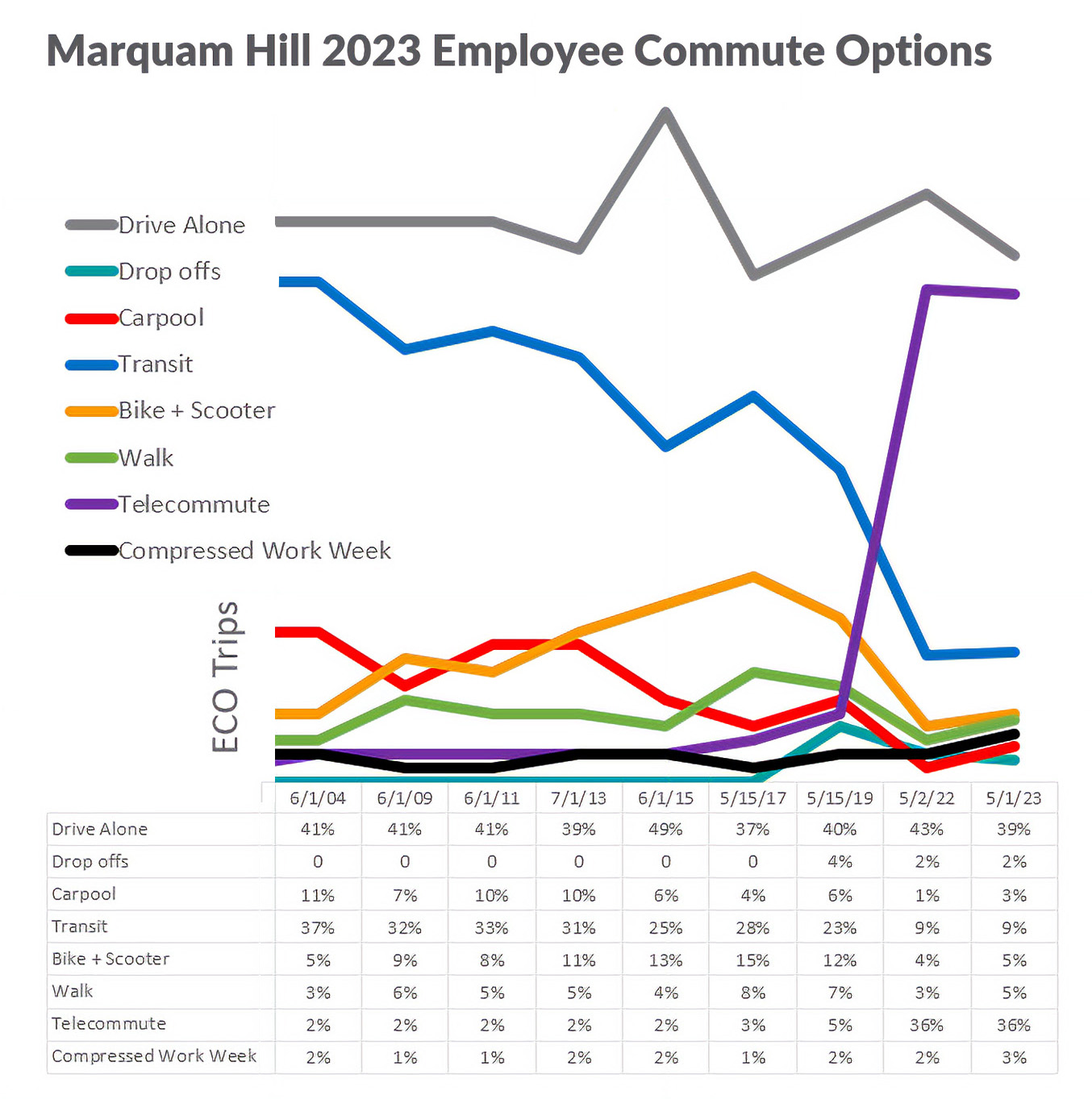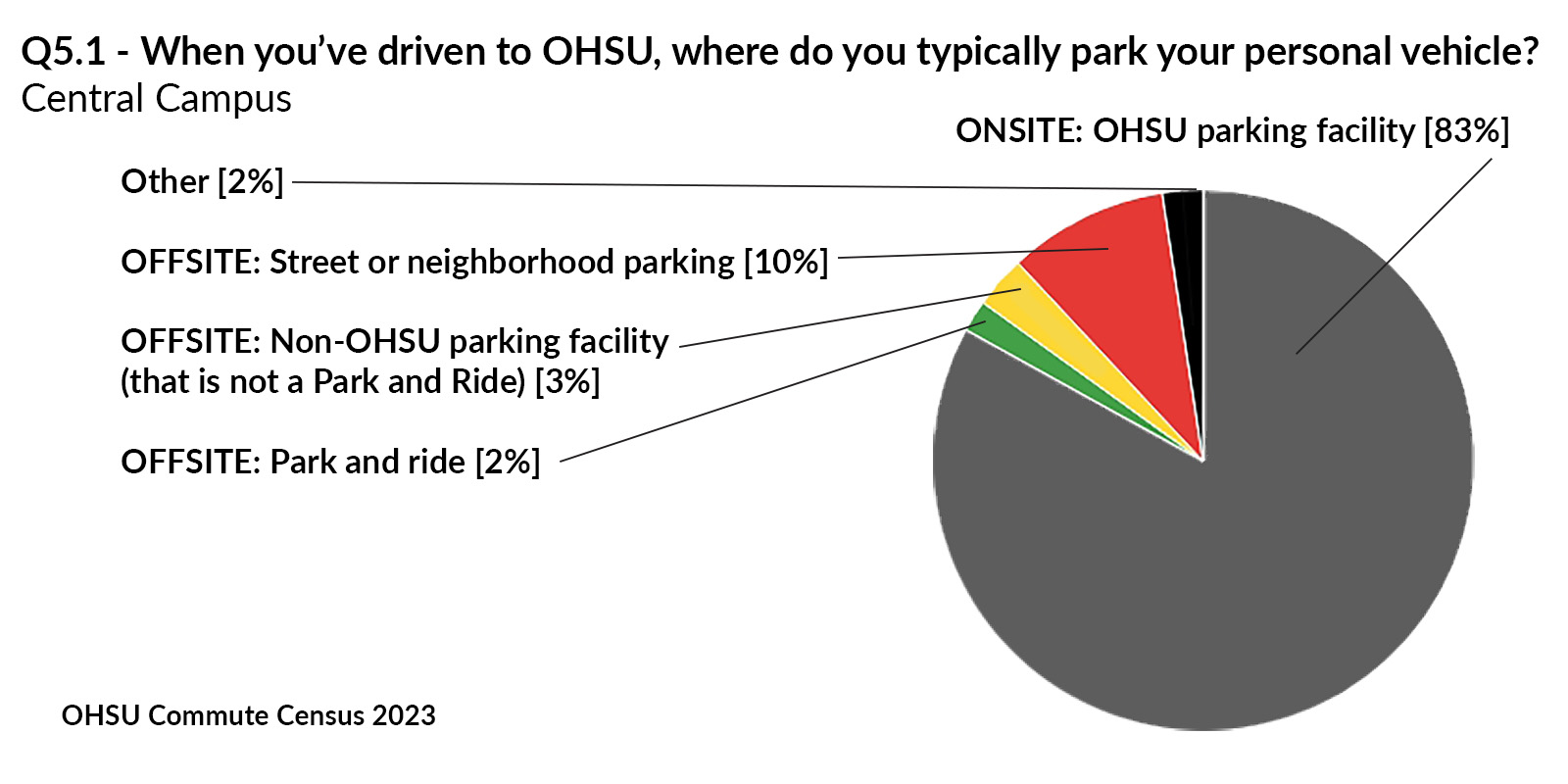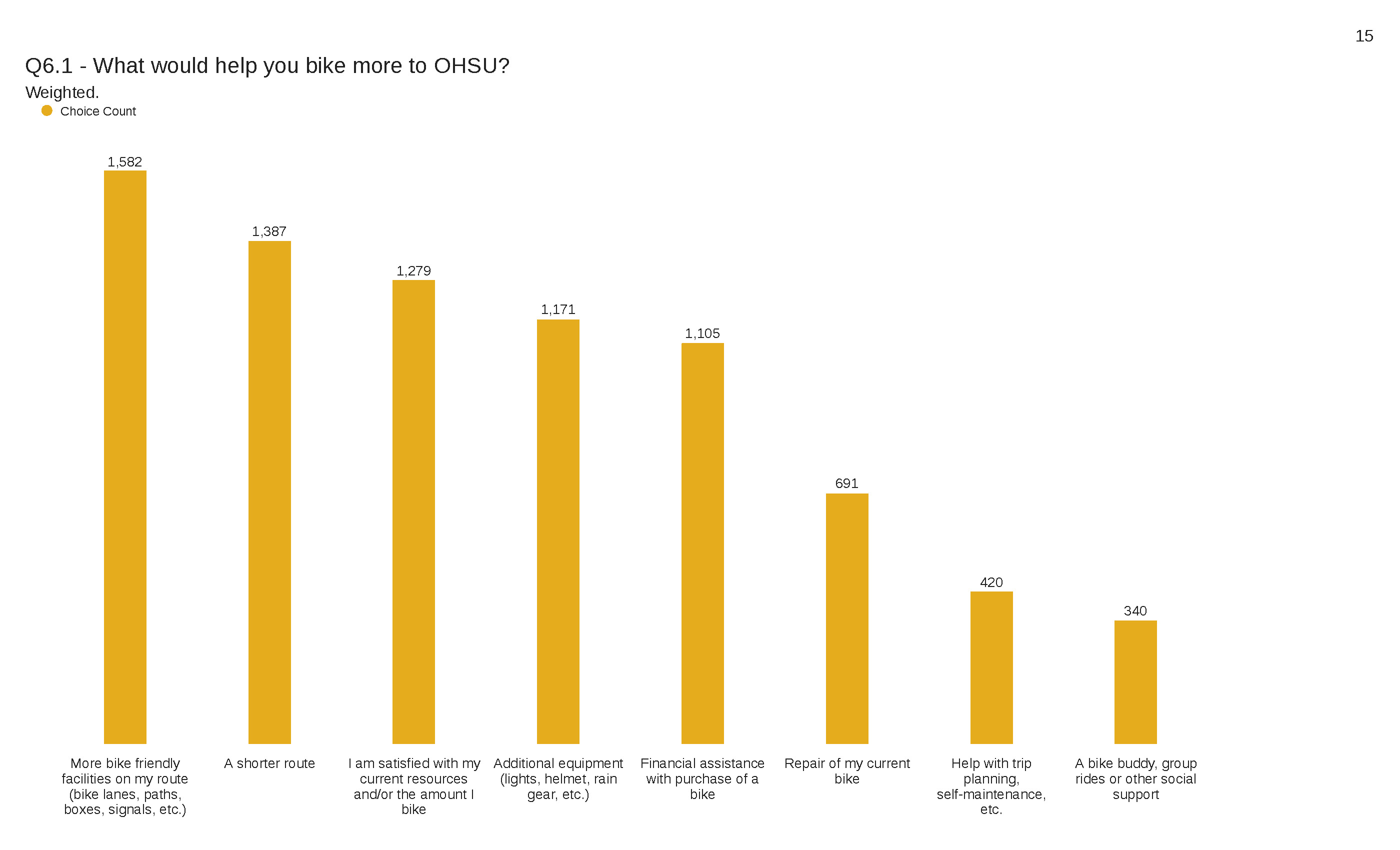OHSU Commute Census 2023
Introduction
The purpose of the OHSU Commute Census is to complete the requirements of the Employee Commute Options survey mandated by the State of Oregon and, additionally, to collect the feedback and experiences of OHSU employees to improve the transportation experience and access to OHSU sites for all.
For assistance reading charts and tables: Email us here.
See previous OHSU Commute Census reports and other transportation reports here.
2023 survey sites
OHSU has numerous sites across Oregon not represented in this survey. Site selection for this survey is detailed in Limitations and methodology.
Site codes and shorthand site labels may be used in this report's charts.
2023 site codes:
BC: Beaverton Clinic
BP: Beaverton Pharmacy (Creekside and Nimbus)
FA: First Avenue
LM: Lower Marquam (Marquam Plaza and Marquam II)
MH: Marquam Hill
MSB: Market Square Building (and Fifth Avenue Building)
SW: South Waterfront
WC: West Campus
This particular survey fulfills State of Oregon requirements of the Employee Commute Options survey intended to monitor how worksites affect vehicle miles traveled within the Portland metro region. To accurately benchmark a worksite's commute trends, the survey must include people engaged in all commute modes or alternatives to commuting such as working remotely and condensed work weeks.
This survey's sites were limited to locations within the State of Oregon's designated Employee Commute Options area in the greater Portland metro region with more than 100 employees qualified for survey. The survey's participants were limited to OHSU employees who are residents of Oregon and are working 20 hours or more per week at these sites. Sites of more than 400 qualified survey respondents were randomly sampled. A 75% response rate was required of each site's selected participants.
Respondents are people determined as eligible for the ECO Survey: Employees residing in Oregon, employed more than half-time. Among those not represented in this survey are patients, students, contractors, volunteers, temporary employees and visitors not represented. Alternative methods of analyzing the commutes of OHSU community members can be found here:
Generally, these results have a 2% margin of error with small fluctuations in the margin of error possible depending on the question and how results are filtered.
Essential findings

Remote work remains constant.
Each weekday, OHSU's support of telework diverts about 4,700 drive alone trips from OHSU sites, 5,500 vehicles from parking onsite, and 7,500 vehicle trips.
See Chart 9.1.
Biking is limited by off campus barriers.
These issues include lack of bike-friendly routes and long commutes. See chart 6.1.
Transit challenges are time-based.
Potential riders are most concerned with the length of their commute. See chart 7.6.
Walking has significant growth potential.
Although most respondents do not live within walking distance of work, 16% of respondents say they are within walking distance. This infers that walking's growth potential is about 4x. See chart 3.4.
Employee Commute Options
Employee Commute Options (ECO) are surveyed according to guidelines set by the State of Oregon. ECO trips represent weekday trips people take to a work site (or combination of work sites) or alternatives used in place of these trips such as working remotely or working longer shifts over less days (compressed work week). The ECO Mode Split is the percent each mode is recorded at the time of survey.


The pie chart combines results from all sites, weighting each site based on its population. Combined results like this will most closely match the largest sites and least closely match the smallest sites. Marquam Hill, which accounts for about 2/3rds of the employee population, only deviates from these results within 1 to 2 percentage points.
Results, separated by site, are provided in the adjacent table. See the site codes here.
Q3.3 Provided the right resources and conditions, what would be your preferred options?
Telework has been the most preferred option over multiple survey years.
With the exception of transit, each alternative to driving has a higher percentage of people saying they would prefer the option, given the right resources, than are currently commuting by the options.
Q3.4 Do you have access to any of the below?
9 out of 10 respondents say they could drive. The majority of people who don’t drive are making an active choice not to do so.
Access to commutes modes is relatively high with the exception of walking and carpool. Modes that people have current access to have growth potential should barriers be addressed.
What do we mean by access? In the survey, access to each commute option was defined as such
- Driving: An automobile available for commuting.
- Transit: Service near your home or a convenient Park and Ride.
- Telework: A role possible to perform as telework at least part-time.
- Bike: Any device legal in bike lanes and multi-use paths.
- Dropped off: May be dropped off by a personal acquaintance or ride hail company.
- Carpool: I have a schedule and route that makes sharing a ride possible.
- Walk: A home location walkable to OHSU.
Q2.8 Rank how the following affect your current experience commuting or teleworking.
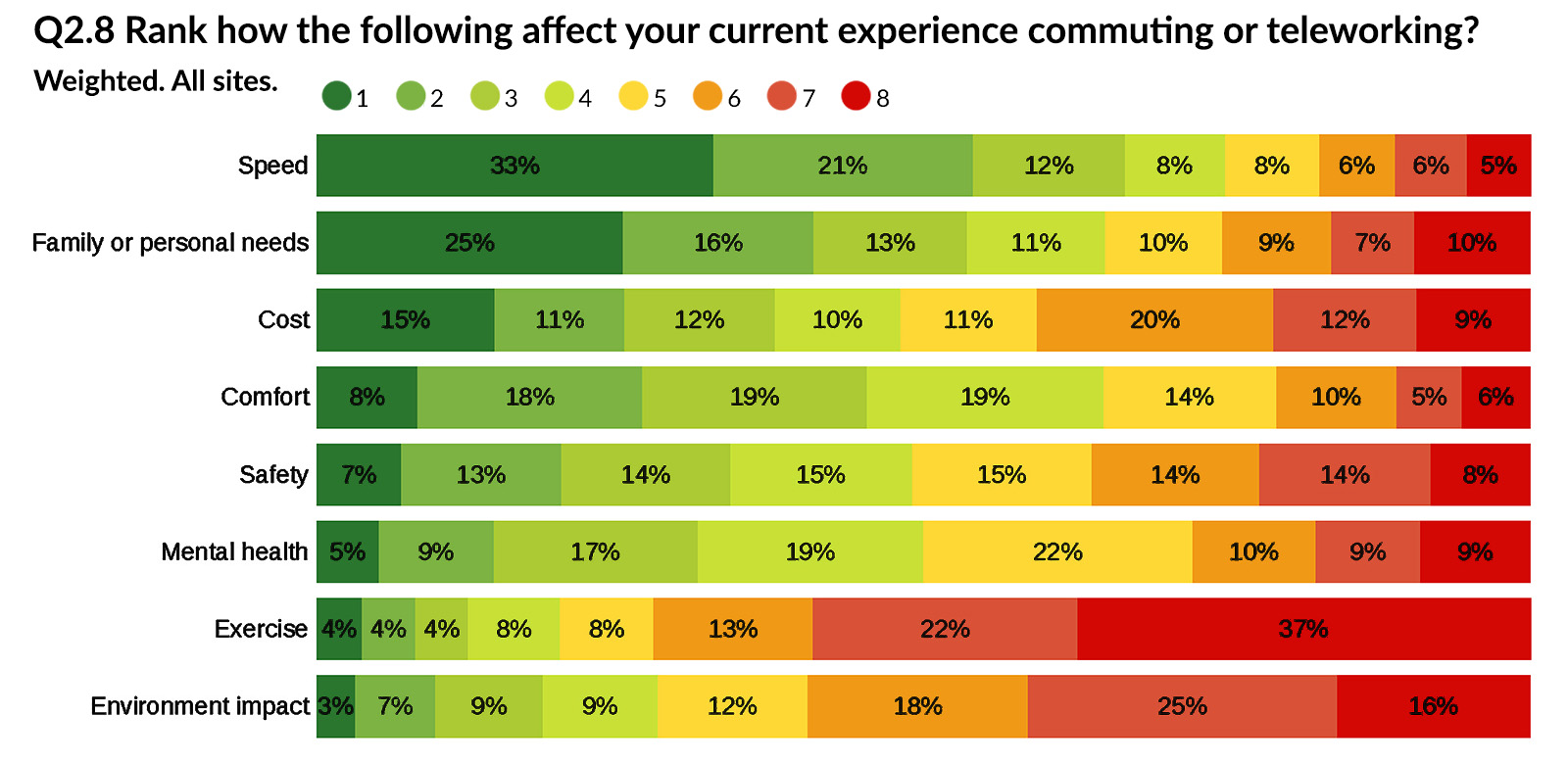
People rank practical concerns like speed, personal needs and cost highly. As important as environmental impact, for example, may be, it might not have much traction as a motivating factor.
Q3.1 How many miles people travel one way to Marquam Hill

People who carpool, although a small sample size, were more likely to say they live further away from their worksites. Carpool might have particular sway with people who whose length of travel makes walking, biking and transit difficult or not possible.
Q10.2 Have any of the following programs assisted your commute at any time?

The transit pass remains the most popular program overall over several years of survey.
Q3.2 Respondents who ride the aerial tram

Several thousand people ride the Tram on a typical weekday and a significant number of these riders are OHSU employees. Employees ride the Tram as a means of commuting particularly to access a variety of transit modes and to make self-powered modes like walking and biking significantly less challenging. Employees also use the Tram for intra-campus trips. This question helps us understand which commuters are traveling to the hill or waterfront with or without aid of the Tram.
Trends over time

Travel trends over time
Travel trends over time for all sites
Q2.5 asked respondents what travel modes they take frequently or expect to take in the future.
This question helps capture how many people in total are using each mode, rather than just what primary mode people take the week of survey. For this reason, each mode is a percent of the total respondents independent of other modes.
The difference between everyone who takes a particular mode and the people who primarily choose that mode represents that mode's potential growth as a mode of choice by people who may already have the means to choose it.
93% of respondents, across all sites, work remotely at least some of the time while only 7% do not.

Driving

Q4.1 Roughly what do you pay per day for parking when commuting to OHSU?

Wage Based Daily Parking launched at OHSU's central sites as an option for OHSU employees on payroll in December 2021. This program broadened the spread parking rates across 7 wage brackets.
Q5.2 What barriers prevent people from using alternatives to driving alone

As with previous years, people are most concerned with the time or distance involved in traveling to campus. Cost of living increases may exacerbate this problem by making it more financially challenging to locate housing close to work, school and healthcare. Marquam Hill also has a combination of last mile problems created by the campus's topography.
Safety continues to be a reported barrier to alternatives to driving. While driving poses its own risks, safety is an idea that people personally define in a wide variety of ways. Some ways OHSU has addressed safety includes working with regional partners to improve transit and multi-use paths, bicycle helmet giveaways, guaranteed ride home and late night ride share.
Remote work

Q9.1 Are you interested in any of these long term strategies

Condensed work weeks have long been a prominent transportation strategy tracked by the State of Oregon via the ECO Survey. In the past year, OHSU has also expanded on flexible work space options for employees with spaces around campus that can be booked free-of-charge and are equipped with essential office equipment.
Q9.2 Options people would choose if telework was not available

According to this year's respondents and estimated total headcount based on the random sample population:
Each weekday, OHSU's support of telework diverts about 4,700 drive alone trips from OHSU sites, 5,500 vehicles from parking onsite, and 7,500 vehicle trips.
See how random samples are calculated and how estimated totals are calculated here [LINK]
See how vehicle trips are calculated here.
See how parking onsite is calculated here.
Telework vs time

These three questions arise from the observation, in previous surveys, that people may not work remotely at the rate they would prefer or is even possible, given their role. This pattern can vary widely depending on each respondent's circumstance, including their work role, home setup, and potential or actual commute.
Transit

Q7.6 Do you typically use a park and ride?
About one in five transit-riding respondents (18%) say they use a park and ride. These are free parking facilities that make transit possible for people who may not live near transit or otherwise have very long commute times.
OHSU has compiled a list of park and rides with direct transit connections to campus at:
Q7.4 How many transit lines people take in a single trip

More than a third of respondents take more than one transit line. Direct lines to OHSU sites are essential but OHSU riders also travel by every transit line in the region.
Q7.5 Factors that would make people more likely to take transit.

Each year of survey, travel time remains the top deciding factor for people considering transit. This is a challenge because it takes buses longer to travel the last mile to Marquam Hil than to most destinations around the region. This is due to the hill's topography which prevents straight streets and wider streets that might accommodate transit-only lanes. Aerial trams have helped accommodate this for thousands of commuters but additional solutions need to be explored for people for whom the tram is a significant detour.
Biking and walking

Q10.1 Have any of the following bike or walk programs assisted your commute at any time?
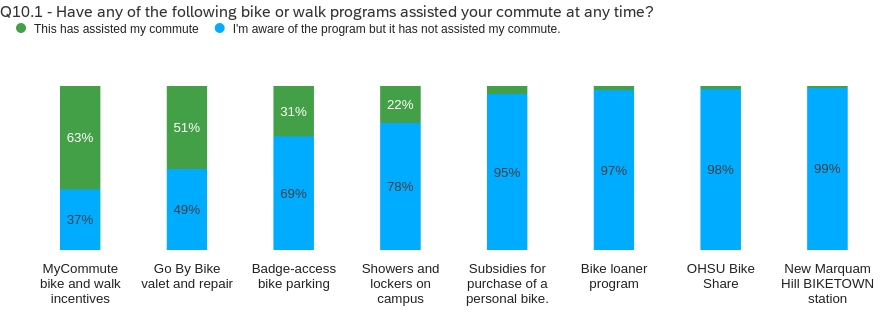
Appendix

Survey questions
The survey is administered online via Qualtrics. A print version of the survey is below, for reference. The format and flow differs from the online version. The online version includes display logic to reduce each respondent's total questions and likelihood that they will see questions irrelevant to their experience. This is intended to reduce survey fatigue and increase rates of survey completion.
Terms and definitions
The below working definitions were provided to respondents for the purpose of completing the survey. These definitions are only for the practical purpose of interpreting the survey and not necessarily how these terms are applied elsewhere, such as in regards to OHSU policies and procedures.
- Drive alone
A single driver traveling in any motorized vehicle (including motorcycles) not legally permitted in a bike lane.
- Bike
Any device street legal in the bike lane, including bikes, compact scooters, skateboards, roller skates and e-bikes without emissions. Does not include assistive devices such as wheelchairs, adaptive scooters or other devices that may be used in indoor settings (see "Walk").
- Carpool
Multiple people sharing a vehicle that will be parked and remain for an extended period at the last destination. Does not include being dropped off by a driver who is immediately returning home or providing multiple rides (Uber, Lyft). Includes vanpool.
- Drop off / Ride hail
Includes passenger vehicles where the driver does not remain at the destination. Includes Uber, Lyft and rides from household members who are not remaining on site.
- Transit
Includes mass transit vehicles such as a bus, streetcar, light rail, train or ferry.
- Walk
Includes walking, running and using personal mobility devices such as a wheelchair.
- Telework
When working off site and not commuting to an onsite location the same day. Synonymous with telecommute and working remotely/offsite/virtual at home, a co-working space, etc.
